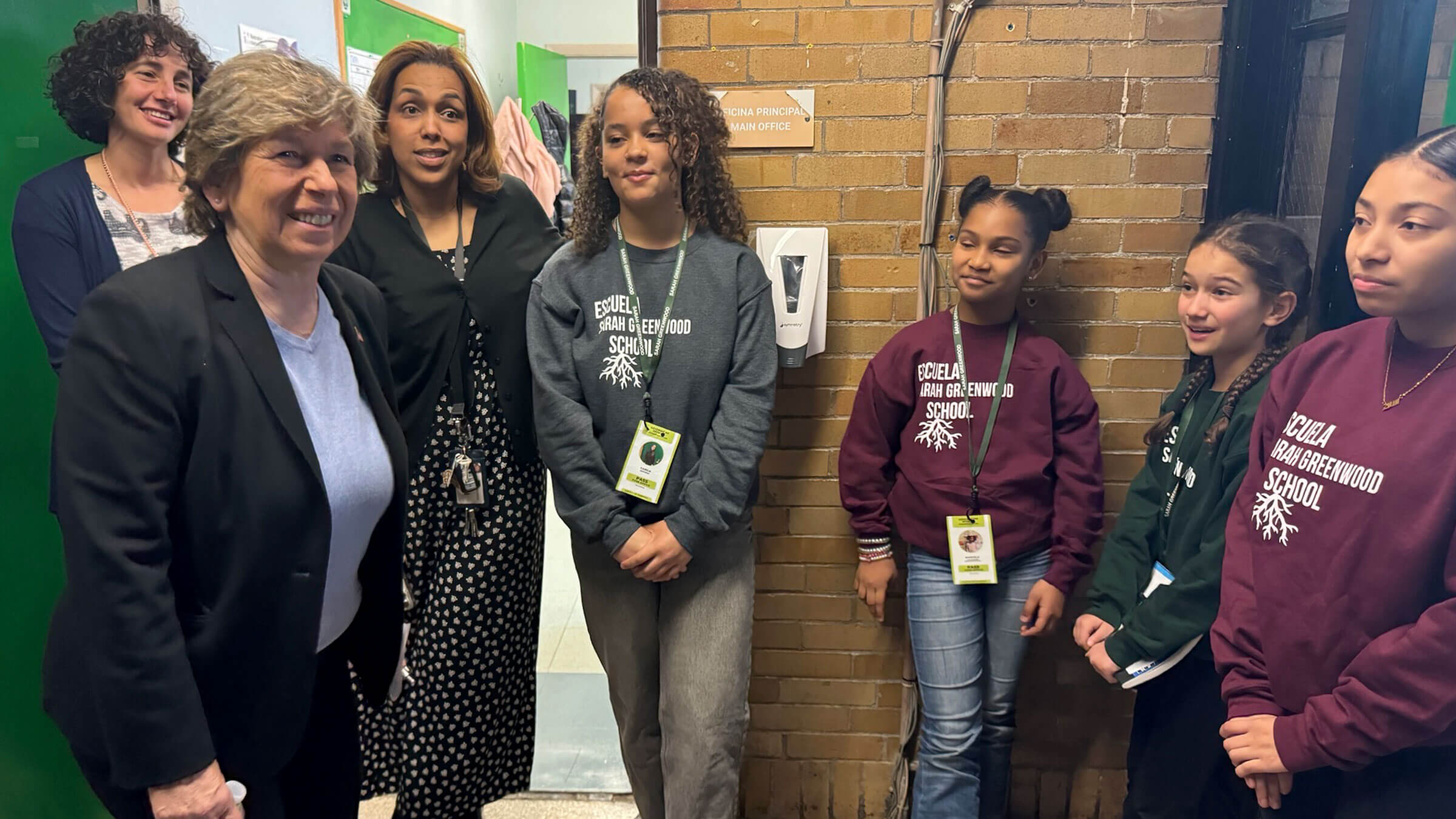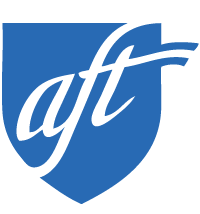Connecting through community schools
Community schools are both a place and a partnership to help students and families thrive.

Weingarten, left, with student leaders and staff at Sarah Greenwood School in Boston on April 11.
I have been crisscrossing the country on a tour of community schools—public schools that are both a
place and a partnership between educators, students, families, community members and service
providers. They’re all different, because they start with the premise of providing their particular school
community what it wants and needs to thrive. From services for immigrant and refugee families in
Kansas City, Mo., to financial literacy classes and adult education in Cincinnati, to clothes closets with
everything from winter coats to prom dresses in Boston, community schools are one of the most
effective strategies we have to help students and their families thrive.
Community schools are also a powerful antipoverty strategy. More than 11 million children live in
poverty in the United States—the equivalent of the number of residents in Maine, Minnesota,
Mississippi and Montana combined. Community schools address barriers to student success, from
hunger to hopelessness. They lessen life’s hardships by connecting students and families with supports
like physical and mental health care, legal services, English classes and housing. Through meaningful
partnerships with families, engaging and empowering students, and deep community connections,
community schools create environments where not only are students and families welcome but they
want to be there.
It doesn’t take much to start a community school; it stems from community aspiration and requires a
community coordinator (which can be paid for by federal Title I dollars). That person can make a huge
difference. Take Lilliana Arteaga, the dynamic community hub coordinator at Mario Umana Academy, a
K-8 school in Boston, who has built a network of 60 partners for her school in the last two years. She
connects students and families to everything from fresh produce and groceries, to a well-stocked
clothes closet, to dental checkups, to outdoor adventures. And Umana has expanded after-school
programs in response to parents’ work schedules, offering swimming lessons, culturally relevant dance
classes and a soccer program.
Community schools are grounded in empowerment and shared decision-making. Students on the
student advisory board at another K-8 public school in Boston, the Sarah Greenwood School, gave me a
tour of their school. They explained that the board surveys students and families about their needs and
priorities and that those results inform decisions at the school.
In my first speech as president of the AFT in 2008, I called for a vast expansion of community schools.
Since then, AFT local unions in Chicago, Los Angeles, New York and elsewhere have worked to make that
vision real. Schools like Umana and Sarah Greenwood are the result of the Boston Teachers Union’s
decadelong campaign for whole-child and family wraparound support. The union and Boston Public
Schools just reached an agreement that will expand community hub schools to 20 next year, up from 14,
and will prioritize schools slated for closure or merger to become hub schools.
I recently visited the Collins Academy High School, a community school in Chicago, with Mayor Brandon
Johnson and three teachers union leaders, Stacy Davis Gates, Dan Montgomery and Tony Johnston, who
are calling for state and federal funding to increase the number of sustainable community schools in the city from 20 to 200. Our message is clear: Community schools not only change lives for the better, they
also are smart investments. Research shows that community schools produce an average $7 to $15
return on investment for every $1 spent.
The AFT is investing in close to 1,000 community schools, and our monthlong tour aims to lift up this
transformational strategy. One of our stops is Buena Vista Horace Mann K-8 Community School in San
Francisco. When the wellness team at BVHM found more and more families struggling with housing and
unable to find shelter services, school staff came together with students’ families to set up an
emergency shelter in the school gym, providing a safe space for 140 students and families from across
the city. Rather than arriving at school exhausted, hungry and stressed—or not getting to school at
all—unhoused students in the Stay Over program at least are rested and nourished. And families feel
supported, not judged.
The AFT is fighting to make community schools the norm, not the exception. We welcome the support
of the Biden-Harris administration, which has expanded grants for full-service community schools since
taking office—from $25 million in 2020 to $150 million in 2023.
I wish I had a magic wand to eliminate the economic, social, emotional and educational challenges that
rob too many children of the opportunities they deserve. But I have hope when I see what’s happening
in community schools. In a world in which many people feel that they are on their own, there is
something magical when students, families, school staff and community partners come together to
solve challenges and create supportive environments where disadvantage is not destiny.
Learn more at www.aft.org/realsolutions.













